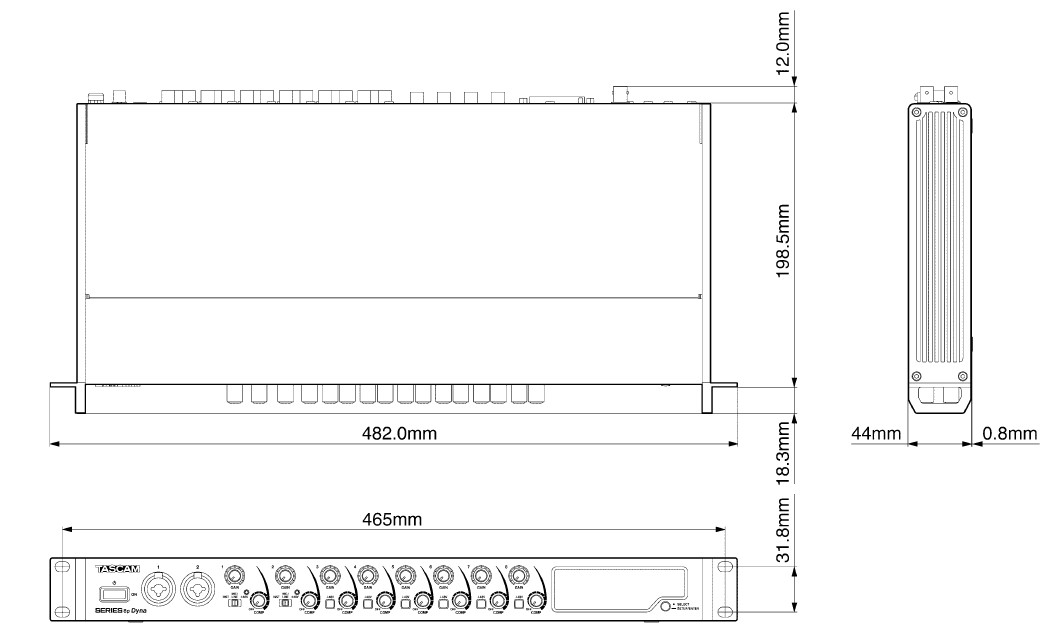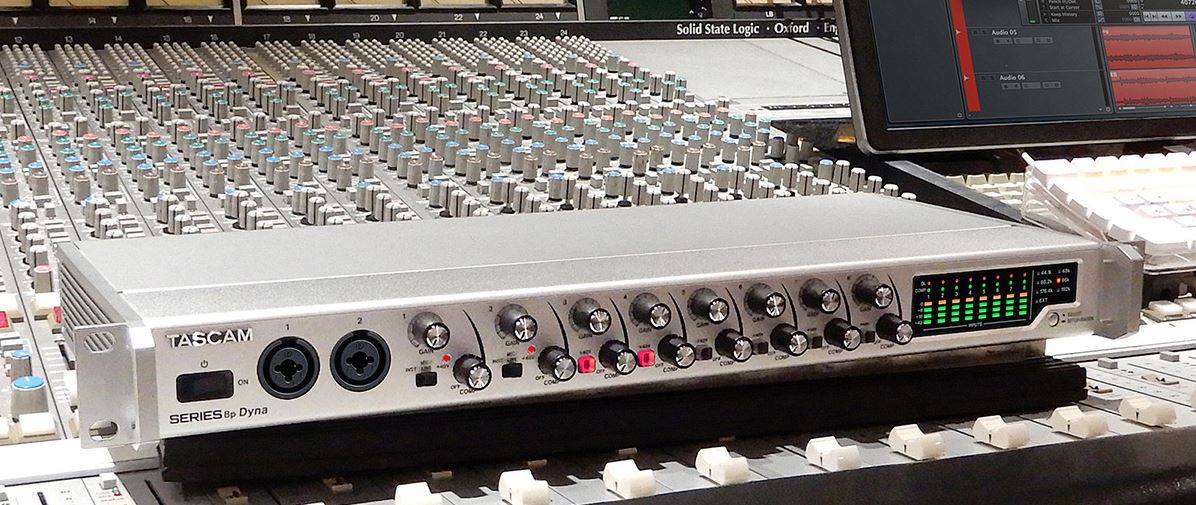![]()
Tascam Series 8p Dyna Microphone Preamp
About Tascam
Tascam is a well-known brand in the audio recording and production industry, particularly in the field of portable audio recorders, audio interfaces, and other audio equipment. The company’s name stands for “TEAC Audio Systems Corporation of America,” and it has a long history dating back to the 1970s.
Here are some key points about Tascam:
- History: Tascam is a division of TEAC Corporation, a Japanese company that specializes in audio and video equipment. Tascam was created in the 1970s to focus specifically on professional audio recording and production equipment.
- Portastudio: Tascam gained widespread recognition with the introduction of Portastudio, a groundbreaking product that allowed musicians to record their music at home using a cassette-based multitrack recorder. The Portastudio revolutionized home recording and became popular in the 1980s.
- Product Range: Tascam produces a wide range of audio equipment, including audio interfaces, digital multitrack recorders, field recorders, mixing consoles, studio monitors, headphones, and more. They cater to both amateur and professional audio enthusiasts.
- Digital Audio Workstations (DAWs): Tascam also offers software solutions and DAW controllers to complement their hardware products. This allows users to integrate their Tascam hardware with popular digital audio workstation software.
- Field Recorders: Tascam is well-known for its field recorders, which are portable devices used for capturing high-quality audio in various environments. These are often used by journalists, filmmakers, musicians, and sound designers for location recording.
- Audio Interfaces: Tascam produces audio interfaces for connecting instruments and microphones to computers. These interfaces are popular among musicians and producers for home and studio recording setups.
- Legacy: Tascam has a strong legacy in the music industry and is trusted by many professionals for its reliable and high-quality audio equipment.
- Affordability: Tascam products are often praised for offering good value for the money, making them accessible to a wide range of users.

Specifications
Ratings
- Sampling frequencies
44.1, 48, 88.2, 96, 176.4, 192 kHz - Quantization bit depth
24-bit - Input channels
8 channels - Analog output channels
8 channels - OPTICAL OUT (S/MUX) output channels
• 8 channels S/MUX (44.1/48 kHz)
A: Channels 1-8
B: Channels 1-8
• 8 channels S/MUX2 (88.2/96 kHz)
A: Channels 1-4
B: Channels 5-8
• 4 channels S/MUX4 (176.4/192 kHz)
A: Channels 1-2
B: Channels 3-4
Analog audio input ratings
- Mic inputs (balanced)
Front panel 1-2 input jacks (when the input switch is set to MIC/LINE)
Rear panel MIC/LINE INPUT 3-8 jacks
Connectors: XLR-3-31 equivalent (1: GND, 2: HOT, 3: COLD)
Input impedance: 2.2 kg
Rated input level: • -58 Bu (0.001 Vrms, GAIN knob at maximum) • -6 dBu (0.388 Vrms, GAIN knob at minimum)
Maximum input level: +10 Bu (2.45 Vrms)
Gain range: 52 dB
- Instrument inputs (unbalanced)
Front panel 1-2 input jacks (when the input switch is set to INST)
Connectors: 6.3 mm (1/4″) standard TS jacks (Tip: HOT, Sleeve: GND)
Input impedance: 900 k or higher
Rated input level: • -58 dBV (0.0012 Vrms, GAIN knob at maximum) • -6 dB (0.501 Vrms, GAIN knob at minimum)
Maximum input level: +10 dBV (3.162 Vrms)
Gain range: 52 dB
- Line inputs (balanced)
Front panel 1-2 input jacks (when the input switch is set to MIC/LINE)
Rear panel MIC/LINE INPUT 3-8 jacks
Connectors: 6.3 mm (1/4″) standard TRS jacks (Tip: HOT, Ring: COLD, Sleeve: GND)
Input impedance: 10 kR
Rated input level: • -48 Bu (0.0003 Vrms, GAIN knob at maximum) • +4 dBu (1.228 Vrms. GAIN knob at minimum)
Maximum input level: +24 dBu (12.282 Vrms)
Gain range: 52 dB
- Compressor
3:1 ratio
30 dB threshold range
Analog outputs
- Analog output (balanced, ANALOG OUT)
Connector: D-sub 25-pin
Locking screws: No. 4-40 UNC (inch type)
Nominal output level: +4 dBu (1.228 Vrms)
Maximum output level: +20 dBu (7.75 Vrms)
Output impedance: 200 R or lower
Applicable load impedance: 2 kg or higher
- Line outputs (balanced, LINE OUTPUT 1-8)
Connectors: 6.3 mm (1/4″) standard TRS jacks (Tip: HOT, Ring: COLD, Sleeve: GND)
Output impedance: 200 Ror lower
Nominal output level: +4 dBu (1.228 Vrms)
Maximum output level: +20 dBu (7.75 Vrms)
Digital audio output ratings
- OPTICAL OUT (S/MUX)
Connectors: OPTICAL (JEITA RC-5720C)
Signal format: Multi-channel optical format (supports S/MUX2 and S/MUX4 when 88.2, 96, 176.4 or 192 kHz)
Control input/output
- WORD IN connector
Connector: BNC
Input voltage: 2.0 Vpp – 5.0 Vpp
Input impedance: 75 Q +10%
Permitted frequency deviation during external synchronization:±100 ppm
Terminal on/off switch
- WORD OUT connector
Connector: BNC
Output voltage: 2.0 Vpp (into 75 ©)
Output impedance: 75 Q +10%
Sampling frequencies: 44.1, 48, 88.2, 96, 176.4 and 192 kHz
OUT/THRU switch
Audio performance
- Mic amp EIN (equivalent input noise)
-127 dBu or lower - Analog input and output
- Frequency response
MIC/LINE -> LINE OUT
20 Hz – 40 kHz: # 0.5 dB (JEITA), 40 kHz – 80 kHz: ‡5 dB (JEITA) - S/N ratio
116 dB (MIC/LINE/INST to LINE OUT, GAIN knob at minimum, JEITA) - Distortion
0.0007% (MIC/LINE to LINE OUT, 1 kHz sine wave, maximum input level, GAIN knob at minimum)
0.0009% (INST to LINE OUT, 1 kHz sine wave, maximum input level, GAIN knob at minimum) - Crosstalk
119 dB (MIC to LINE OUT, 1 kHz sine wave, GAIN knob at minimum)
- Analog input to digital output (S/MUX)
- Frequency response
(MIC/LINE (analog) to digital output (S/MUX))
At 44.1/48 kHz and 20 Hz – 20 kHz: #0.5 dB (JEITA)
At 88.2/96 kHz and 20 Hz – 40 kHz: # 0.5 dB (JEITA)
At 176.4/192 kHz and 20 Hz – 80 kHz: ‡5 dB (JEITA) - S/N ratio
113 dB (44.1/48 kHz)
113 dB (88.2/96 kHz)
111 dB (176.4/192 kHz)
(MIC/LINE/INST to digital output (S/MUX), GAIN knob at minimum, JEITA) - Distortion
0.001% (MIC/LINE/INST to digital output (S/MUX), 1 kHz sine wave, maximum input level, GAIN knob at minimum) - Crosstalk
114 dB (MIC (analog) to digital output (S/MUX), 1 kHz sine wave, GAIN knob at minimum)
General
- Power
DC 12 V AC adapter (PS-P1230) - Power consumption
16 W - Dimensions
482 × 44.8 X 228.8 mm (W x H x D, including protrusions) - Weight
2.6 kg - Operating temperature range
0 – 40° C (32 – 104° F)
Dimensional drawings

- TASCAM is a trademark of TEA CORPORATION, registered in the U.S. and other countries.
- Other company names, product names, and logos are the trademarks or registered trademarks of their owners.
- Specifications and appearance are subject to change without notice.
- All information included in this document is as of Nov 2019.
FAQS About Tascam Series 8p Dyna Microphone Preamp
The tascam — is it a preamp?
outstanding preamp for microphones
Is a preamp required for a dynamic microphone?
To for your microphone to function, you need an audio interface or microphone preamplifier.
What purpose does a microphone preamp serve?
The incoming signal from the microphone is first amplified to a usable level, and then the appropriate load impedance is supplied for the output.
What does a preamp contain?
tubes 12AX7
What mic preamp setting works the best?
For the male voice, a frequency of 60–80 Hz is ideal, whereas for the female voice, a value of 100–120 Hz is ideal.
Why are preamps necessary?
A preamp increases a weaker signal to line level.
What is a preamp’s mic level?
A mic preamp increases the signal’s volume before it is routed to a mixer or recording device.
Does preamp quality have an impact?
Contrary to popular belief, a preamp only slightly affects how the sound is shaped.
What makes it a preamp, and why?
(PREAMPlifier) A term that means “before the amp,”
Do preamps boost volume?
A preamp boosts the gain by taking the weak signal.
For more manuals by Tascam, Visit Manualsdock
[embeddoc url=”https://manualsdock.com/wp-content/uploads/2023/10/Tascam-Series-8p-Dyna-Microphone-Preamp-Specification-Sheet.pdf” download=”all”]


